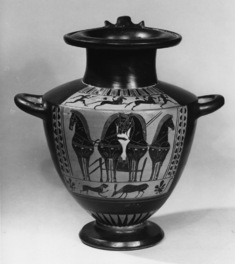Hydria with a Quadriga
(Ancient Greece )
A hydria is a water jug with three handles, two horizontal ones to carry the vessel and a third vertical handle to easily pour out the contents. The main scene depicts a four-horse chariot, or quadriga, and its charioteer from a frontal view. Below the chariot is the word "kalos." The adjective encompasses meanings equivalent to English "good," "noble," and "handsome," and appear frequently on vases, often associated with a name. The term had an aristocratic connotation, which is visually represented here through the quadriga.
Inscription
Provenance
Provenance (from the French provenir, 'to come from/forth') is the chronology of the ownership, custody, or location of a historical object. Learn more about provenance at the Walters.
Don Marcello Massarenti Collection, Rome, no. 221; Henry Walters, Baltimore, 1902, by purchase; Walters Art Museum, 1931, by bequest.
Conservation
| Date | Description | Narrative |
|---|---|---|
| 7/27/1987 | Treatment | x-ray |
Geographies
Greece, Attica (Place of Origin)
Measurements
H: 11 1/4 x W: 10 1/16 x Diam: 7 5/16 in. (28.5 x 25.5 x 18.5 cm)
Credit Line
Acquired by Henry Walters with the Massarenti Collection, 1902
Location in Museum
Not on view
Accession Number
In libraries, galleries, museums, and archives, an accession number is a unique identifier assigned to each object in the collection.
In libraries, galleries, museums, and archives, an accession number is a unique identifier assigned to each object in the collection.
48.32



